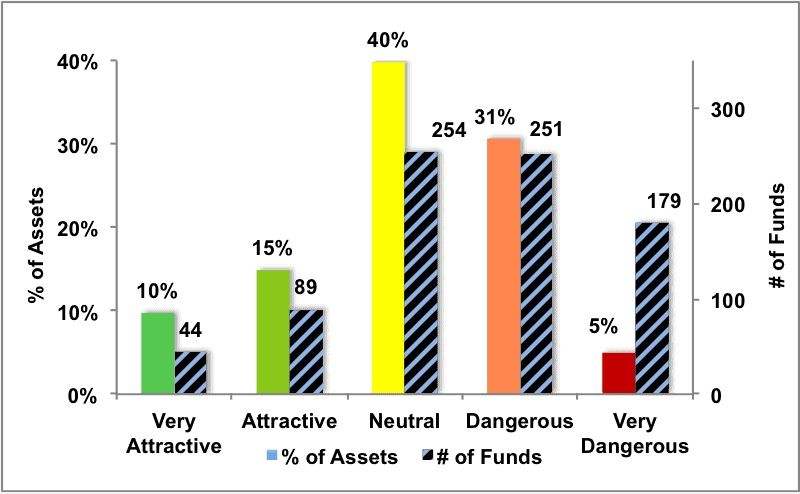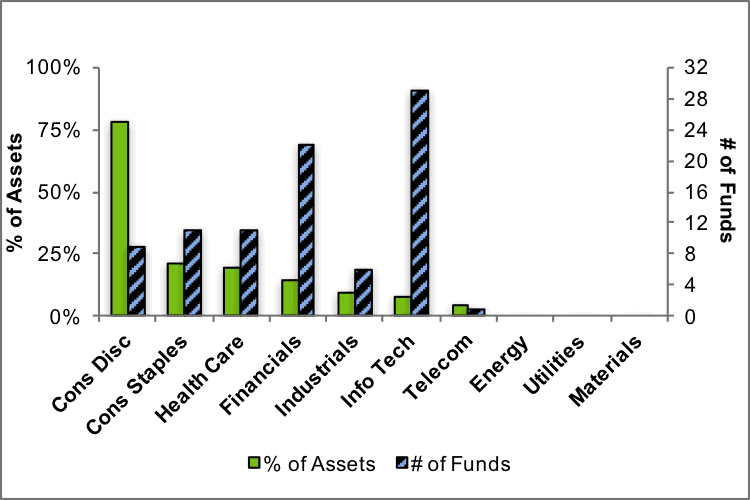At the beginning of the fourth quarter of 2016, only the Consumer Staples and Consumer Discretionary sectors earn an Attractive-or-better rating. Our sector ratings are based on the aggregation of our fund ratings for every ETF and mutual fund in each sector. See last quarter’s Sector Ratings here.
Investors looking for sector funds that hold quality stocks should look no further than the Consumer Staples and Consumer Discretionary sectors. These sectors house the highest rated funds. Figures 4 through 7 provide more details. The primary driver behind an Attractive fund rating is good portfolio management, or good stock picking, with low total annual costs.
Attractive-or-better ratings do not always correlate with Attractive-or-better total annual costs. This fact underscores that (1) cheap funds can dupe investors and (2) investors should invest only in funds with good stocks and low fees.
See Figures 4 through 13 for a detailed breakdown of ratings distributions by sector. See our ETF & mutual fund screener for rankings, ratings and reports on 7000+ mutual funds and 400+ ETFs. Our fund rating methodology is detailed here.
All of our reports on the best & worst ETFs and mutual funds in every sector are available here.
Figure 1: Ratings For All Sectors
Source: New Constructs, LLC and company filings
To earn an Attractive-or-better Predictive Rating, an ETF or mutual fund must have high-quality holdings and low costs. Only the top 30% of all ETFs and mutual funds earn our Attractive or better ratings.
Consumer Staples Select Sector SPDR Fund (XLP) is the top rated Consumer Staples fund. It gets our Very Attractive rating by allocating over 19% of its value to Attractive-or-better-rated stocks.
ConAgra Foods, Inc. (CAG: $48/share) is one of our favorite stocks held by XLP and earns an Attractive rating. Since 2008, CAG has grown after-tax operating profit (NOPAT) by 9% compounded annually. At the same time, the company has improved its return on invested capital (ROIC), from 7% in 2008 to 8% over the last twelve months (TTM). Further showcasing the strength of CAG’s business, it has generated cumulative $1.7 billion in free cash flow (FCF) over the past five years. Despite the fundamental strength of the business, CAG remains undervalued. At its current price of $48/share, CAG has a price to economic-book-value (PEBV) ratio of 1.1. This ratio means that the market expects ConAgra’s NOPAT to grow by only 10% over its remaining corporate life. This expectation seems rather pessimistic given ConAgra has grown NOPAT by 9% each year since 2008. If CAG can maintain 2016 NOPAT margins (12%) and grow NOPAT by only 5% compounded annually for the next decade, the stock is worth $68/share today – a 42% upside.
Rydex: Energy Services Fund (RYESX) is the worst Energy fund. It gets our Very Dangerous rating by allocating over 72% of its value to Dangerous-or-worse-rated stocks. Making matters worse, it charges investors total annual costs of 6.35%.
RPC Inc. (RES: $17/share) is one of our least favorite stocks held by RYESX and earns a Dangerous rating. RPC’s economic earnings have declined from $27 million in 2005 to -$230 million in 2015, and further declined to -$281 million over the last twelve months. RPC’s ROIC has declined from 22% in 2005 to a bottom-quintile -14% TTM. Despite the deteriorating fundamentals, RPC remains significantly overvalued. To justify its current price of $17/share, RPC must immediately achieve 14% pre-tax margins (average over the last five years, compared to -29% TTM) and grow revenue by 14% compounded annually for the next 13 years. This expectation seems overly optimistic given RPC’s decade of shareholder value destruction. This scenario also assumes RPC can grow revenue and NOPAT without spending on working capital or fixed assets, which is highly unlikely, but allows us to create a very optimistic scenario. For reference, RPC’s invested capital has grown on average $83 million (7% of 2015 revenue) per year over the last five years.
Figure 2 shows the distribution of our Predictive Ratings for all sector ETFs and mutual funds.
Figure 2: Distribution of ETFs & Mutual Funds (Assets and Count) by Predictive Rating
Source: New Constructs, LLC and company filings
Figure 3 offers additional details on the quality of the sector funds. Note that the average total annual cost of Very Dangerous funds is almost ten times that of Very Attractive funds.
Figure 3: Predictive Rating Distribution Stats
* Avg TAC = Weighted Average Total Annual Costs
Source: New Constructs, LLC and company filings
This table shows that only the best of the best funds get our Very Attractive Rating: they must hold good stocks AND have low costs. Investors deserve to have the best of both and we are here to give it to them.
Ratings by Sector
Figure 4 presents a mapping of Very Attractive funds by sector. The chart shows the number of Very Attractive funds in each sector and the percentage of assets in each sector allocated to funds that are rated Very Attractive.
Figure 4: Very Attractive ETFs & Mutual Funds by Sector
Source: New Constructs, LLC and company filings
Figure 5 presents the data charted in Figure 4.
Figure 5: Very Attractive ETFs & Mutual Funds by Sector
Source: New Constructs, LLC and company filings
Figure 6 presents a mapping of Attractive funds by sector. The chart shows the number of Attractive funds in each sector and the percentage of assets allocated to Attractive-rated funds in each sector.
Figure 6: Attractive ETFs & Mutual Funds by Sector
Source: New Constructs, LLC and company filings
Figure 7 presents the data charted in Figure 6.
Figure 7: Attractive ETFs & Mutual Funds by Sector
Source: New Constructs, LLC and company filings
Figure 8 presents a mapping of Neutral funds by sector. The chart shows the number of Neutral funds in each sector and the percentage of assets allocated to Neutral-rated funds in each sector.
Figure 8: Neutral ETFs & Mutual Funds by Sector
Source: New Constructs, LLC and company filings
Figure 9 presents the data charted in Figure 8.
Figure 9: Neutral ETFs & Mutual Funds by Sector
Source: New Constructs, LLC and company filings
Figure 10 presents a mapping of Dangerous funds by fund sector. The chart shows the number of Dangerous funds in each sector and the percentage of assets allocated to Dangerous-rated funds in each sector.
The landscape of sector ETFs and mutual funds is littered with Dangerous funds. Investors in Energy funds have put over 86% of their assets in Dangerous-rated funds.
Figure 10: Dangerous ETFs & Mutual Funds by Sector
Source: New Constructs, LLC and company filings
Figure 11 presents the data charted in Figure 10.
Figure 11: Dangerous ETFs & Mutual Funds by Sector
Source: New Constructs, LLC and company filings
Figure 12 presents a mapping of Very Dangerous funds by fund sector. The chart shows the number of Very Dangerous funds in each sector and the percentage of assets in each sector allocated to funds that are rated Very Dangerous.
Figure 12: Very Dangerous ETFs & Mutual Funds by Sector
Source: New Constructs, LLC and company filings
Figure 13 presents the data charted in Figure 12.
Figure 13: Very Dangerous ETFs & Mutual Funds by Sector
Source: New Constructs, LLC and company filings
This article originally published here on October 4, 2016.
Disclosure: David Trainer, Kyle Martone, and Kyle Guske II receive no compensation to write about any specific stock, sector or theme.
Scottrade clients get a Free Gold Membership ($588/yr value). Login or open your Scottrade account & find us under Quotes & Research/Investor Tools.














1 Response to "4Q16 Sector Ratings For ETFs & Mutual Funds"
Very interesting. I think that this will be helpful.